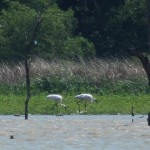NOTE: This post is part of a continuing series of observations: [ First | << Prev | Next >> ]
June 15, 2013 marks nearly one full week at Lake Lewisville for our five wandering Whooping Cranes. This quintet of sub-adults cranes—also known as the Fenton Five—are from the same program in Louisiana as the two cranes that stayed at Lake Ray Hubbard earlier in the spring.
Reportedly, these five birds left Louisiana and stopped briefly in Polk County in southeast Texas. From there they made their way to the metroplex, taking up residence on a Lake Lewisville floodplain.
The cranes roam far and wide on the overgrown dried lake bed, and change locations frequently. The habitat here is quite expansive, and offers a number of vantage points that allow human observers to honor the minimum 2000 foot viewing distance required by Texas State legal guidelines.



Two thousand feet is quite a long distance away for observing wildlife. At that range there is little that even the most powerful camera equipment can do to record good quality images. On this occasion, however, I was fortunate enough to be in the right position for a low altitude flyover.
I had setup roughly 2500 feet away from the cranes and was well concealed in the Button Bushes growing up along the margins of the floodplain. The cranes were on the far side of the dried lake bed foraging in the tall grass. I had been observing the cranes for nearly a half hour, when the entire group took to the air.


Together, the cranes made two lazy circles in an effort to gain a little altitude, and then broke for the lake. But, they did not take the direct route. Instead, I was shocked to see them heading straight for me. They flew almost directly overhead as the passed by.

The pictures I took during this flyover allow for an excellent look at the gear these cranes are wearing. All of the birds have metal ankle bands. In addition, they all also sport multicolored bands around each thigh. Tracking devices with wire antennas can be seen attached to these leg bands.
Some birds have two of these types of devices, one on each leg. It is my understanding that these devices are GPS trackers. The second device, when present, may be a camera of some kind is a VHF transmitter used for close range, real-time tracking. These birds are carefully monitored.




NOTE: This post is part of a continuing series of observations: [ First | << Prev | Next >> ]







Amazing photos!! What a net experience that must have been!
This was seriously cool! More surprises coming in next week’s post. Stay tuned!
These pictures are magnificent! First I watched week 2 with five Cranes, joined by two others as the flock of seven were engaged in the daily activities.
Then I noticed the website for week one. Unbelievable up close pictures of these beautiful birds. Two years ago I watched as the utralights lead the flock into the skies near New Glarus, WI. Exiting then. The views in Week 1 are so clear, so close up what a treasure to share with those of us who are homechair travelers via the internet. Thank You!
I love sharing the pictures, Ella Faye! Thanks for stopping by to see them!